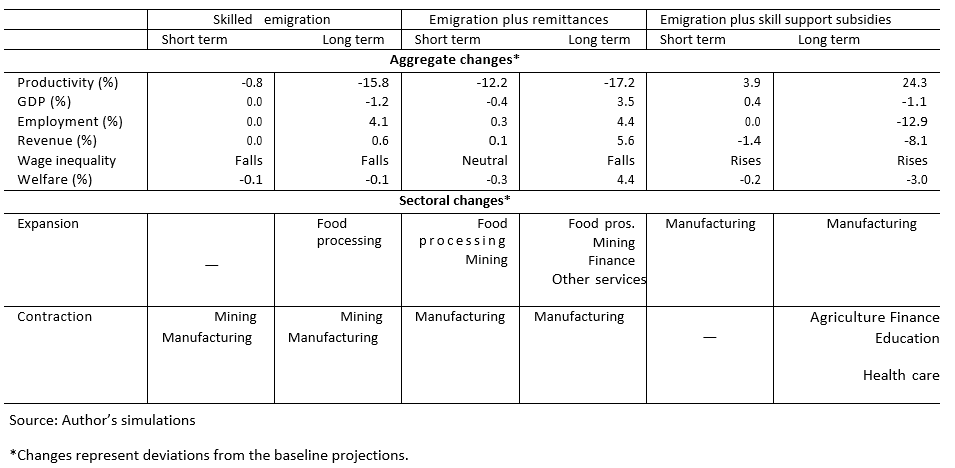Skilled labour emigration in South Africa: Exploring the long-term implications
South Africa has experienced rising numbers of skilled workers emigrating, losing more skilled workers than it receives. Unlike skilled immigrants, emigrants tend to be highly skilled, South African-trained, driven by non-monetary factors, and less likely to return. Skilled emigration threatens to undermine efforts to close the country’s chronic skills gap and have far-reaching implications for productivity, growth, income distribution, and structural change.
Skilled emigration without offsetting measures has adverse long-term productivity and growth effects.
Remittances offset both negative growth and productivity effects but only in the medium-to-long term. In the short term, higher import demand and prices reduce output.
Non-revenue-neutral government skill support subsidies reverse output only in the short term. In the medium-to-long term, they reduce opportunities for lower-skill categories, the resulting unemployment, and lower government revenue reverse growth and productivity gains.
Skilled labour emigration reduces real wage inequality because South Africa’s labour market is predominantly semi-skilled. Remittances reduce wage inequalities, but only in the medium-to-long term. In contrast, subsidies increase the productivity and wages of skilled workers relative to semi- and unskilled labour; wage inequality rises.
Skilled emigration has positive but marginal welfare effects. Remittances improve welfare outcomes in the medium-to-long term. Conversely, skill support subsidies gradually reduce welfare, due to higher unemployment and wage inequality combined with a fall in output growth.
Study background
South Africa is both a recipient and source for migrants. In 2019 there were 4.2 million immigrants, and 824,000 South Africans residing elsewhere. Overall, it is a net recipient of migrants, but it loses more skilled workers than it receives. In 2019, only 294,417 working immigrants were skilled, compared to 410,550 highly skilled emigrants in the OECD region. This number is significantly higher when emigrants in non-OECD countries are considered, and the category is broadly defined as skilled. Furthermore, emigrants tend to be South African-trained, whereas 75% percent of immigrants are from Africa. According to global rankings, Africa’s top five universities are South African. These facts imply that skilled workers entering and leaving the country are not perfectly substitutable.
Given South Africa’s acute skills shortage, losing skilled workers to emigration weakens efforts to close the skills gap. Furthermore, the loss of human capital reduces productivity and constrains the economy’s capacity to innovate and adopt new technologies. Because skilled labour income is a significant source of tax revenue, a reduction in it reduces government revenue and limits revenue redistribution potential. Additionally, because education in South Africa is publicly funded, emigration constitutes a permanent loss in public investment. Moreover, when the social return in education exceeds the private return, a loss in human capital can reduce welfare.
Acknowledging the centrality of migration in South Africa’s development, the government has included migration in its development strategy. Although skilled emigration is central to the development debate, empirical studies on its effects on the source country are limited and inconclusive. The differing positions on the impact of skilled emigration highlight its complexity. Understanding the potential country-specific effects of skilled emigration is essential for designing and implementing targeted policy interventions, and for long-term budgetary planning and social-economic development. The study aimed to contribute to the debate by highlighting the potential long-term effects of skilled emigration.
 Migration
Migration
To understand the long-term implications of skilled emigration for South Africa, a three-region recursive dynamic CGE model was used. It included structural features of the labour market, such as three categories of labour – skilled, semi-skilled, and unskilled. In addition, it linked labour productivity to skilled emigration by allowing productivity effects to be determined endogenously. Three scenarios simulated over 20 years (2020–2040) were considered.
Reliable data is key to understanding how South Africa can address its emigration problem or harness its benefits. This requires improving migration data collection through inter-government collaboration and surveys.
Skilled emigration threatens to undermine South Africa’s development objectives. Reversing this requires discouraging skilled workers from leaving or encouraging return migration by addressing concerns such as safety and security.
Conversely, the South African government can engage emigrants as development partners by creating infrastructure and institutions that support diaspora philanthropy, encouraging collaborative research, and acknowledging the achievements of former or non-resident South Africans.
Emigration negatively affects productivity. The government needs other avenues to enhance productivity, such as knowledge transfer, investment, and collaborative research, and to reduce barriers to technology transfer and adoption—including corruption, bureaucracy, and poor infrastructure.
Policies that support remittances and skills development can offset the adverse effects of emigration. This requires using revenue-neutral skill support subsidies and reducing barriers to remittance flows. For skill support policies to be effective, the government needs to address the skill problem without worsening unemployment.
South Africa’s manufacturing already operates below capacity, and emigration worsens this. Increasing manufacturing value-added requires strengthening internal demand by creating more jobs for semi-skilled and unskilled workers.
First, the long-term effects of skilled emigration in the absence of remittances and government offsetting policies. The shocks were applied as positive sector-specific emigration rates to manufacturing, finance and communication, education, and health care. Second, emigration with remittances modelled as a 2% shock to private household income. Third, emigration combined with a 10% non-revenue-neutral skill-support subsidy to skill-intensive and emigration-sensitive sectors. Projected baseline equilibrium values were used as benchmarks for the simulations.





